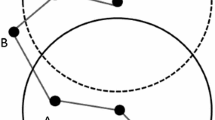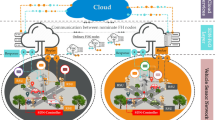Abstract
Efficient data delivery in vehicular networks has received increasing attention in recent years. Existing routing protocols for vehicular networks can be loosely divided into two classes: road based routing (RBR) and road oblivious routing (ROR). RBR finds a routing path along roads while ROR does not explicitly forward packets along roads. Our empirical study based on real trace-driven experiments shows that using either of an RBR algorithm or an ROR algorithm alone in a realistic vehicular network setting leads to deficiency. This results from the fact that network conditions can be different at different locations and evolving over time. Motivated by this important observation, this paper proposes an adaptive routing algorithm called RWR that adapts its routing strategy to network dynamics as the packet travels from the source to the destination. Extensive simulations based on a large dataset of real vehicular traces collected from around 2,600 taxis in Shanghai have been conducted. Comparison study shows that RWR produces higher delivery ratio than TSF and GPCR, representative routing algorithms of RBR and ROR, respectively. It achieves low delivery delay at the same time.








Similar content being viewed by others
References
Biem, A., Bouillet, E., Feng, H., Ranganathan, A., Riabov, A., Verscheure, O., Koutsopoulos, H., & Moran, C. (2010). IBM infosphere streams for scalable, real-time, intelligent transportation services. In Proceedings of the ACM SIGMOD.
Zhou, P., Zheng, Y., & Li, M. (2012). How long to wait? Predicting bus arrival time with mobile phone based participatory sensing. In Proceedings of the ACM MobiSys, pp. 379–392.
Gibbons, P. B., Karp, B., Ke, Y., Nath, S., & Seshan, S. (2003). Irisnet: An architecture for a worldwide sensor web. IEEE Pervasive Computing, 2(4), 22–33.
Hartenstein, H., Bochow, B., Ebner, A., Lott, M., Radimirsch, M., & Vollmer, D. (2001). Position-aware ad hoc wireless networks for inter-vehicle communications: the fleetnet project. In Proceedings of the ACM MobiHoc, pp. 259–262.
Xu, F., Guo, S., Jeong, J., Gu, Y., Cao, Q., Liu, M., & He, T. (2011). Utilizing shared vehicle trajectories for data forwarding in vehicular networks. In Proceedings of the IEEE INFOCOM, p. 2.
Chen, Y. S., Lin, Y. W., & Pan, C. Y. (2011). DIR: Diagonal-intersection-based routing protocol for vehicular ad hoc networks. Telecommunication Systems, 46(4), 299–316.
Jeong, J., Guo, S., Gu, Y., He, T., & Du, D. H. C. (2010). TSF: Trajectory-based statistical forwarding for infrastructure-to-vehicle data delivery in vehicular networks. In Proceedings of the IEEE ICDCS, pp. 557–566.
Skordylis, A., & Trigoni, N. (2008). Delay-bounded routing in vehicular ad hoc networks. In Proceedings of the ACM MOBICOM, pp. 341–350.
Zhao, J., & Cao, G. (2006). VADD: Vehicle-assisted data delivery in vehicular ad hoc networks. In Proceedings of the IEEE INFOCOM, pp. 1–12.
Lochert, C., Mauve, M., Ler, H. F., & Hartenstein, H. (2005). Geographic routing in city scenarios. ACM SIGMOBILE Mobile Computing and Communications Review, 9(1), 69–72.
Karp, B., & Kung, H. T. (2000). GPSR: Greedy perimeter stateless routing for wireless networks. In Proceedings of the ACM MOBICOM, pp. 243–254.
Leontiadis, I., & Mascolo, C. (2007). GeOpps: Geographical opportunistic routing for vehicular networks. In Proceedings of the WoWMoM, pp. 1–6.
Jeong, J., Guo, S., Gu, Y., He, T., & Du, D. (2009). TBD: Trajectory-based data forwarding for light-traffic vehicular networks. In Proceedings of the IEEE ICDCS, pp. 231–238.
Lochert, C., Scheuermann, B., Wewetzer, C., Luebke, A., & Mauve, M. (2008). Data aggregation and roadside unit placement for a VANET traffic information system. In Proceedings of the ACM international workshop on VehiculAr Inter-NETworking, pp. 58–65.
Acer, U., Giaccone, P., Hay, D., Neglia, G., & Tarapiah, S. (2011). Timely data delivery in a realistic bus network. In Proceedings of the IEEE INFOCOM, pp. 446–450.
Burgess, J., Gallagher, B., Jensen, D., & Levine, B. N. (2006). Maxprop: Routing for vehicle-based disruption-tolerant networks. In Proceedings of the IEEE INFOCOM, p. 1¨C11.
Leontiadis, I., Costa, P., & Mascolo, C. (2010). Extending access point connectivity through opportunistic routing in vehicular networks. In Proceedings of the IEEE INFOCOM, pp. 1–5.
Lin, X., Lu, R., Liang, X., & Shen, X. S. (2011). STAP: A social-tier-assisted packet forwarding protocol for achieving receiver-location privacy preservation in VANETs. In Proceedings of the IEEE INFOCOM, pp. 2147–2155.
Naumov, V., & Gross, T. R. (2007). Connectivity-aware routing (CAR) in vehicular ad hoc networks. In Proceedings of the IEEE INFOCOM, pp. 1919–1927.
Wu, Y., Zhu, Y., & Li, B. (2011). Trajectory improves data delivery in vehicular networks. In Proceedings of the IEEE INFOCOM, pp. 2183–2191.
Zhu, H., Chang, S., Li, M., Naik, S., & Shen, S. (2011). Exploiting temporal dependency for opportunistic forwarding in urban vehicular networks. In Proceedings of the IEEE INFOCOM.
Chen, K. H., Dow, C. R., Chen, S. C., Lee, Y. S., & Hwang, S. F. (2010). HarpiaGrid: A geography-aware grid-based routing protocol for vehicular ad hoc networks. Journal of Information Science and Engineering, 26(3), 817–832.
Nzouonta, J., Rajgure, N., Guiling, W., & Borcea, C. (2009). VANET routing on city roads using real-time vehicular traffic information. IEEE Transactions on Vehicular Technology, 58(7), 3609–3626.
Lu, R., Lin, X., & Shen, X. (2010). Spring: A social-based privacy-preserving packet forwarding protocol for vehicular delay tolerant networks. In Proceedings of the IEEE INFOCOM.
Toyota Motor Corporation (TMC). TMC develops onboard DSRC unit to improve traffic safety. http://www2.toyota.co.jp/en/news/09/09/0903.html.
Wu, Y., Zhu, Y., & Li, B. (2012). Infrastructure-assisted routing in vehicular networks. In Proceedings of the IEEE INFOCOM.
Huang, H., Luo, P.-E., Li, M., Li, D., Li, X., Shu, W., et al. (2007). Performance evaluation of SUVnet with real-time traffic data. IEEE Transactions on Vehicular Technology, 56(6), 3381–3396.
Polus, A. (1979). A study of travel time and reliability on arterial routes. Transportation, 8(2), 141–151.
Acknowledgments
This research is supported by Shanghai Pu Jiang Talents Program (10PJ1405800), Shanghai Chen Guang Program (10CG11), NSFC (No. 61170238, 60903190, 61027009, 60933011, 61202375, 61170237), 973 Program (2005CB321901), MIIT of China (2009ZX03006-001-01), Doctoral Fund of Ministry of Education of China (20100073120021), National 863 Program (2009AA012201 and 2011AA010500), HP IRP (CW267311), SJTU SMC Project (201120), STCSM (08dz1501600, 12ZR1414900), Singapore NRF (CREATE E2S2), National Key Technology R&D Program of China (2012BAKI7B15-1), NSFC/RGC (N-HKUST610/11), HKUST (RPC11EG29, SRFI11EG17-C and SBI09/10.EG01-C), Huawei Technologies Co. Ltd. (HUAW18-15L0181011/PN), ChinaCache Int. Corp. (CCNT12EG01) and Guangdong Bureau of Science and Technology (GDST11EG06). In addition, it is partially supported by the Open Fund of the State Key Laboratory of Software Development Environment (Grant No. SKLSDE-2010KF-04), Beijing University of Aeronautics and Astronautics.
Author information
Authors and Affiliations
Corresponding author
Rights and permissions
About this article
Cite this article
Zhu, Y., Qiu, Y., Wu, Y. et al. On adaptive routing in urban vehicular networks. Wireless Netw 19, 1995–2004 (2013). https://doi.org/10.1007/s11276-013-0581-1
Published:
Issue Date:
DOI: https://doi.org/10.1007/s11276-013-0581-1




